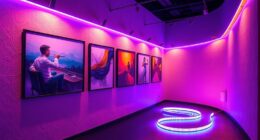To grow a laser rainbow with a CD diffraction grating, shine a laser pointer directly onto the shiny, grooved surface of the CD while holding it steady. The tiny grooves act like a diffraction grating, splitting the laser light into a spectrum of colors that fan out onto a nearby wall or surface. As you adjust the laser or rotate the CD, you’ll see the rainbow pattern change, revealing the fascinating physics behind light and diffraction. Keep exploring to discover even more about this striking display.
Key Takeaways
- Shine a laser pointer onto a clean, reflective CD surface to produce a diffraction pattern that creates a rainbow spectrum.
- Hold the laser steadily at an angle to maximize the visibility and clarity of the rainbow diffraction pattern.
- Adjust the laser’s position and angle to observe different diffraction patterns and enhance the colorful rainbow effect.
- Use a wall or screen nearby to project the spectrum for easier viewing and to grow a vivid laser rainbow display.
- Experiment with different laser wavelengths or rotate the CD to observe changes and deepen understanding of diffraction phenomena.

You can create a stunning rainbow of laser colors right at home by using a simple CD diffraction grating. This technique leverages the principles of laser diffraction to produce a vivid rainbow spectrum that’s both visually striking and educational. When you shine a laser beam through a CD, the tiny grooves on its surface act as a diffraction grating, splitting the laser light into multiple directions. As a result, you see a spectrum of colors fan out, forming a beautiful rainbow pattern on your wall or screen. It’s an easy, inexpensive way to explore light behavior and enjoy the mesmerizing display of laser diffraction in action.
The process is straightforward. First, you need a laser pointer—preferably a small, focused one for better results. Next, find a clean, reflective CD or DVD. Hold the laser steady and shine it directly onto the shiny, grooved surface of the disc. When the laser hits the surface, it interacts with the tiny grooves, causing the light waves to diffract. This diffraction spreads the laser beam into multiple directions, with each color spreading out at different angles. The result is a clear, colorful rainbow spectrum projected onto a nearby surface. You’ll notice the pattern changes as you move the laser or adjust the angle, revealing the dynamic nature of laser diffraction.
Hold a laser steady on a clean CD to create a vibrant rainbow spectrum through diffraction.
The diffraction pattern you observe depends on the spacing of the grooves on the CD and the wavelength of the laser light. Since CDs are manufactured with precise, microscopic grooves, they serve as effective diffraction gratings for visible laser light. The different wavelengths within the laser beam bend at slightly different angles, creating a spectrum of colors. This visible separation of colors is what makes the rainbow spectrum so enthralling. You can experiment by using lasers of different wavelengths or by rotating the CD to see how the diffraction pattern shifts. It’s a simple yet powerful demonstration of how laser diffraction reveals the wave nature of light and produces those stunning color displays.
You don’t need special equipment beyond a laser pointer and a CD to enjoy this project. It’s perfect for science experiments, educational demonstrations, or just having fun with light. As you explore, you’ll gain a deeper understanding of how diffraction works and how it produces the vibrant rainbow spectrum we associate with laser diffraction. This simple setup offers a hands-on experience that’s both enlightening and visually impressive, all from the comfort of your home. So grab a laser, find a CD, and watch as a beautiful rainbow of laser colors unfolds before your eyes, demonstrating the fascinating physics behind laser diffraction in a way that’s accessible and engaging. Additionally, understanding diffraction gratings can help you better grasp how various optical devices operate and are used in scientific research.
Frequently Asked Questions
How Does a CD Create a Rainbow Effect?
When you look at a CD, the tiny grooves create diffraction patterns that split incoming light into a spectrum of colors. This happens because the CD’s surface acts like a diffraction grating, dispersing light into different wavelengths. As a result, you see a rainbow effect, showcasing the full light spectrum. The diffraction of light by the CD’s grooves is what produces this beautiful, colorful display.
Can This Experiment Be Done With Other Discs?
You can try this experiment with other discs, but results vary due to alternative disc materials and digital media differences. DVDs or Blu-ray discs might work, but their different structures affect diffraction patterns. Keep in mind, older CDs with reflective aluminum layers produce the clearest rainbows. Digital media differences, like laser wavelength and disc composition, influence how well the rainbow effect appears. Experimenting with various discs helps you understand these factors better.
What Safety Precautions Are Necessary?
When working with lasers, safety is vital. You should always wear proper eye protection, avoid direct eye exposure, and keep the laser beam away from your face. Make certain the laser is on a stable surface, never point it at people or animals, and work in a controlled environment. Following laser safety guidelines not only protects your eyes but also prevents accidents, guaranteeing a safe and enjoyable experiment.
How Can the Rainbow Be Made More Vibrant?
To make the rainbow more vibrant, you should focus on enhancing color and increasing light intensity. Use a brighter laser or more powerful light source to boost the overall brightness. Adjust the angle of the diffraction grating to optimize color separation, making the hues more vivid. Confirm the environment is dim to reduce ambient light interference, which helps your rainbow appear more striking and colorful.
Is This Method Suitable for Educational Demonstrations?
Yes, this method is suitable for educational demonstrations if you prioritize laser safety and proper optical alignment. You should use low-power lasers, wear safety goggles, and make certain the setup is secure. Properly align the laser with the diffraction grating to produce clear rainbow patterns. This hands-on activity helps students understand diffraction and optics, but always supervise closely and follow safety guidelines to prevent accidents.
Conclusion
Just like the brightest rainbow emerges after a storm, your curiosity can lead to dazzling discoveries. By using simple tools like a CD diffraction grating, you harness the same natural magic that paints the sky. Remember, every spectrum begins with a single light—your willingness to explore transforms ordinary moments into extraordinary insights. Keep experimenting, and soon you’ll find that even a humble disk can uncover the universe’s vibrant secrets, reminding us that wonder is always within reach.









